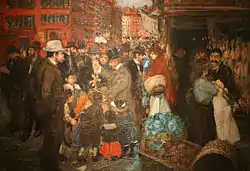Hester Street (Manhattan)
Hester Street is a street in the Lower East Side of the New York City borough of Manhattan.


The street stretches from Essex Street to Centre Street, with a discontinuity between Chrystie Street and Forsyth Street for Sara Delano Roosevelt Park. There is also a discontinuity at Allen Street, which was created in 2009 with the rebuilding of the Allen Street Mall. [1] At Centre Street, Hester Street shifts about 100 feet (30 m) to the north and is called Howard Street to its far western terminus at Mercer Street.
History
In November 1851, the assistant board of aldermen of New York City voted in favor of removing a liberty pole at the junction of Hester Street and Division Street.[2] The Franklin Building Association held its second regular monthly meeting at Washington Hall, on December 3, 1851. The building was located at the corner of Bowery.[3] On April 15, 1912, an investigator reported that a parlor house on Hester Street had three inmates (prostitutes) who were waiting to entertain customers.[4]
It has historically been a center for Ashkenazi Jewish immigrant culture. The sculptor Jacob Epstein was raised at 102 Hester Street. More recently, it has been absorbed by Chinatown, although some kosher and Jewish-owned stores can be found.

At the east end of Hester Street, an open-air market called the Hester Street Fair currently runs on weekends from April through October.[5] The market is on a parcel of land owned by Seward Park Co-op and is run by MTV News Correspondent SuChin Pak, her brother Suhyun Pak, Adam Zeller, and Ron Castellano.
In popular culture
Hester Street is featured in Abraham Cahan's 1896 novel Yekl: A Tale of the New York Ghetto.
As a symbol of the immigrant experience, the street was the title of the 1974 period film Hester Street, adapted from Cahan's novel. [6][7]
Al Stewart references Hester Street as part of the immigrant experience in his song "Murmansk Run/Ellis Island" on his 1980 Album 24 Carrots in part as follows[8]:
Well you wake up in the morning on Hester Street and run to the factory, You can't afford to be late
Working every morning, every evening, every day for your money, Yet there's nothing to save
References
Notes
- Allen & Pike Streets
- New York City, New York Daily Times, 1851-11-13, p. 1.
- Special Notices, New York Daily Times, 1851-11-29.
- Commercialized Prostitution in New York City, George Jackson Kneeland, New ed., rev. to date, New York, 1914, p. 16.
- Chou, Jessica (2011-06-10). "Hester Street Fair". New York. Retrieved 2018-02-02.
- Valeria Tinkler-Villani (2005). Babylon Or New Jerusalem?: Perceptions of the City in Literature. Rodopi. p. 214. ISBN 90-420-1873-9.
- Edward S. Shapiro (May 1995). A Time for Healing: American Jewry Since World War II. JHU Press. p. 151. ISBN 978-0-8018-5124-7.
- "murmansk run /ellis island lyrics". alstewart.com. Retrieved 2018-11-28.
External links
 Media related to Hester Street (Manhattan) at Wikimedia Commons
Media related to Hester Street (Manhattan) at Wikimedia Commons- picture of Hester Street near Essex
- Panorama of Hester St. c1902
- Hester Street Storefronts - photographs of buildings and stores along Hester St from the Lower East Side through Chinatown and Little Italy.